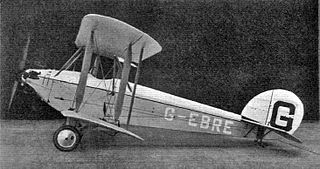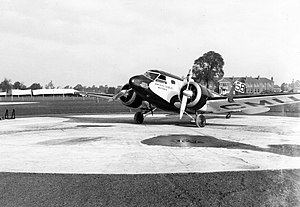
The Avro 618 Ten or X was a passenger transport aircraft of the 1930s. It was a licensed version by Avro of the Fokker F.VIIB/3m.

The Airspeed Consul is a twin-engined light transport aircraft and affordable airliner designed and produced by the British aircraft manufacturer Airspeed Limited. Introduced during the immediate post-war period, it was a straightforward conversion of surplus Airspeed Oxford military trainers that had been extensively used during the Second World War.

Fokker D.XVII, was a 1930s Dutch sesquiplane developed by Fokker. It was the last fabric-covered biplane fighter they developed in a lineage that extended back to the First World War Fokker D.VII.

The Armstrong Siddeley Cheetah is a seven-cylinder British air-cooled aircraft radial engine of 834 cu in capacity introduced in 1935 and produced until 1948. Early variants of the Cheetah were initially known as the Lynx Major.

The Airspeed AS.6 Envoy was a twin-engined light transport aircraft designed and produced by the British aircraft manufacturer Airspeed Ltd.

The Airspeed AS.5 Courier was a British six-seat single-engined light aircraft that was designed and produced by the British aircraft manufacturer Airspeed Limited at Portsmouth. It has the distinction of being the first British aircraft fitted with a retractable undercarriage to go into quantity production.

The Airspeed AS.30 Queen Wasp was a British pilotless target aircraft built by Airspeed Limited at Portsmouth during the Second World War. Although intended for both Royal Air Force and Royal Navy use, the aircraft never went into series production.

The Avro 652 was a 1930s British light airliner, built by A.V. Roe and Company. It was a twin-engine, low-wing monoplane with a retractable undercarriage, and a tailwheel. Although only two were produced, it formed the basis for the successful Avro Anson.

The Avro Cadet is a single-engined British biplane trainer designed and built by Avro in the 1930s as a smaller development of the Avro Tutor for civil use.

The Avro 627 Mailplane was a British biplane developed in 1931 by Avro from the Avro Antelope bomber as a mail plane for use in Canada. Only one was built which ended up being used as a test bed.
The Avro 636 was a single-engined British fighter-trainer built by Avro in the mid-1930s. Four were built for the Irish Air Corps.

The Blackburn L.1 Bluebird was a British single-engine biplane light trainer/tourer with side-by-side seating, built in small numbers by Blackburn Aircraft in the 1920s.

The de Havilland DH.75 Hawk Moth was a 1920s British four-seat cabin monoplane built by de Havilland at Stag Lane Aerodrome, Edgware.

The Koolhoven F.K.51 was a 1930s Dutch two-seat basic training biplane built by the Koolhoven Company.

The Letov Š-31 was a fighter aircraft produced in Czechoslovakia in the early 1930s in a number of variants. All of the aircraft had metal tubular framing and fabric covering with a metal engine cowling.

The Edgar Percival E.P.9 was a 1950s British light utility aircraft designed by Edgar Percival and initially built by his company, Edgar Percival Aircraft Limited and later as the Lancashire Aircraft Prospector by the Lancashire Aircraft Company.

The Cierva C.19 was a 1930s British two-seat autogyro, designed by Spanish engineer Juan de la Cierva. It was built by Avro as the Avro Type 620. It proved to be the most successful and widely produced of the early de la Cierva designs.

The Armstrong Whitworth AW.55 Apollo was a 1940s British four-engine turboprop airliner built by Armstrong Whitworth at Baginton. The aircraft was in competition with the Vickers Viscount but was beset with engine problems and only two were built.

The Civilian Coupé is a British, single-engined two-seat private monoplane built starting in 1929. Only five were made, and it was the Civilian Aircraft Company's only product, but one still flies in the UK.

The Avro 642 Eighteen was a 1930s British monoplane airliner. Only two were built — one twin-engined and the other four-engined. The original had a circular partially glazed nose, but this was changed to a more traditional one. It used the wing of the Avro 618 Ten, which was a license produced Fokker V.II.




















